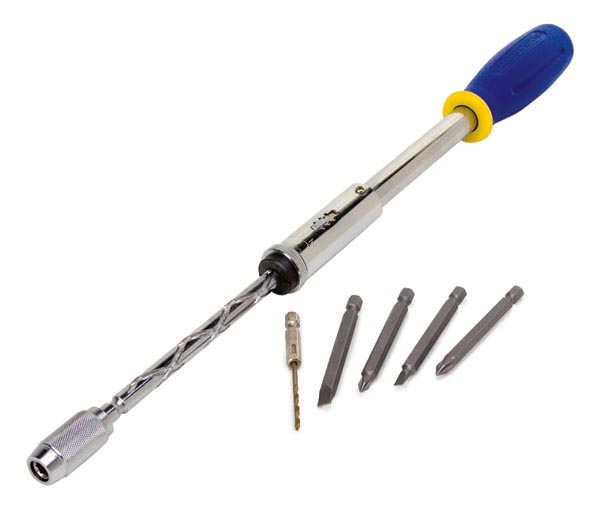
I haven’t met anybody, adult or child, woodworker or not, who doesn’t like a Yankee screwdriver. This tool is as practical for many applications as it is fascinating. I started out with one of these interesting tools, given to me by my father from his toolbox, and now I have eight of them. They’re not hidden away, but conveniently located in the top drawer of my workbench for easy access and use. The others I’ve brought into the school where I teach middle and high school technology. It’s not surprising how many students use them instead of the electric tools that are also available for their use for driving screws. They’re quick, easy, efficient and fun to use.
I’m using the term “Yankee” screwdriver to mean a spiral ratcheting screwdriver, whether or not it was manufactured by Stanley, which apparently gave it this name. Many times they’re referred to as push screwdrivers or spiral screwdrivers in reference to the grooves that transfer the up-and-down pushing motion to rotary motion.
While Stanley coined the name, the Yankee screwdriver was invented by someone else, most likely Zachary T. Furbish while working for the Forest City Screwdriver and Drill Company of Portland, Maine. Two years after its patent in 1895, the company was purchased by the North Brothers Manufacturing Company of Philadelphia. Several of my spiral ratcheting screwdrivers were made by this company which was later bought by The Stanley Works, manufacturers of Stanley tools.
Using a Yankee screwdriver is easy, but using it correctly does take a little practice. Improper settings, pressure or speed can cause the bit to pop out of the screw and cause damage to the wood, or injury to the user. I suggest to first-time users to practice first on some scrap wood. In this way, they can get the proper feel of the tool and to get used to changing the settings.
Depending on the screws you’re using, you might need to drill one or more holes. This, too, can be accomplished with the Yankee screwdriver with drill bits that fit directly into it or into an auxiliary chuck that can be purchased for some models.
Set the screwdriver on the function you want. Most screwdrivers have a selector switch with the forward position for driving screws or a drill bit, the rear position for removing screws or a bit ,and a middle locked setting for operating in a forward ratcheting mode. Pump the drill slowly and with slight pressure at first. Once the screw has been started, speed and pressure may be increased a little. When the screw has reached the surface of the wood, you might need to use the ratcheting action to draw the screw tight. Push the screwdriver to the closed position, lock it and use a ratcheting motion to tighten the screw.
To remove screws, set the screwdriver in the reverse mode and start pushing it with a little pressure. If the screw doesn’t start to come out, close the screwdriver and use the ratcheting mode to loosen it. Once loose, you can release the lock and use the spiral action to complete removal.
Where can you get a Yankee screwdriver? Used ones can often be found at tag sales, in antique shops and on the Internet. I’ve gotten them for as little as $5.00, but most are in the $10.00-$25.00 range. The screwdrivers themselves are usually easier to find than the bits. Many times they don’t have a bit or only come with a slot (flat) bit.
A search on the Internet will reveal many used ratcheting screwdrivers, Yankee screwdrivers, push drills and related tools on sites such as eBay, where I’ve purchased several. Prices were reasonable, even with shipping. The screwdrivers were in good condition, but there was the matter of bits, or lack of them. I also found that it helps to ask if the screwdriver has a return spring. Some models don’t have this feature.
New screwdrivers as well as bits are being sold by several woodworking supply companies. If you’re ordering bits, make sure that you measure the shank diameter that your screwdriver requires. Mine use quarter inch, 3/16″ or 7/32″. Use a twist drill bit of known diameter to help measure the shank size.
If you don’t already have a Yankee screwdriver, consider adding one to your toolbox: you’ll be pleasantly surprised at how easy and fun they are to use, and it won’t set you back a lot of money.
-John Roccanova





